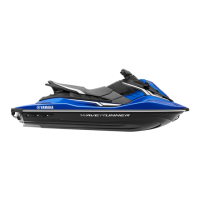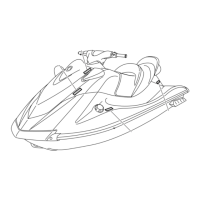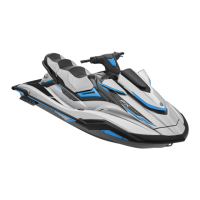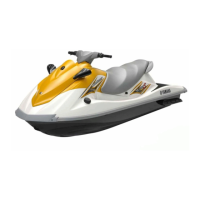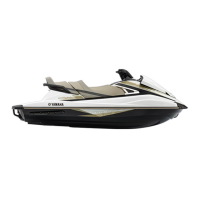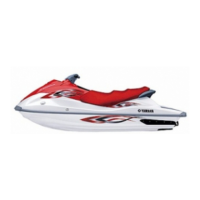Do you have a question about the Yamaha WaveRunner VX 2015 and is the answer not in the manual?
Details on PRI-ID, Craft Identification Number (CIN), and engine serial number.
Location and explanation of manufactured date label and builder's plate for model identification.
Information on critical warning labels and their importance for safe operation.
Identification and purpose of various other labels on the watercraft.
Guidelines on operator age, passenger limits, and skill requirements for safe operation.
Advice on safe speeds, distances, maneuvers, and operating conditions.
Details on potential hazards like exhaust fumes, hot engine parts, and magnetic interference.
Explanation of jet thrust steering, off-throttle steering (OTS), and water-jet propulsion.
Definitions of key terms used in the manual for watercraft operation and components.
Diagrams identifying exterior and interior main components of the watercraft.
Operation and care instructions for the watercraft's remote control transmitter.
Functionality and settings for the Yamaha Security System (lock/unlock modes).
Explanation of start switch, engine stop switch, and engine shut-off switch operations.
Details on using the throttle lever, RiDE lever, and steering system.
Instructions on shifting between forward, neutral, and reverse using the RiDE lever.
Explanation of special operating modes like Low RPM and No-wake modes.
How to activate and use the cruise assist function for maintaining engine speed.
Overview of the information center, its displays, and indicators.
Explanation of speedometer, tachometer, fuel level, and warning indicators.
Information on removing, installing, and using seats and handgrips.
Using the reboarding step, bow eye, stern eyes, and cleats.
Details on bow, glove, and watertight storage compartments, including capacity and load limits.
Recommended fuel types, octane ratings, and refueling procedures.
Recommended engine oil types, grades, and checking the oil level.
Procedures for draining bilge water on land and on water.
Guidelines for securely transporting the watercraft on a trailer.
Essential steps for breaking in the engine to ensure proper performance and longevity.
Comprehensive checklist of pre-launch and post-launch checks for safety and reliability.
Inspections for the engine compartment, fuel system for leaks, and fuel level.
Checks for water separator, engine oil level, bilge water, and battery condition.
Verification of steering system, RiDE lever, throttle lever, and remote transmitter operation.
Ensuring fire extinguisher, safety equipment, hull, deck, and intake are in good condition.
Checks performed after launching, including cooling water outlet and information center.
Guidance on familiarizing with controls and basic techniques for safe operation.
Instructions for starting the engine on water and stopping the engine safely.
Techniques for turning the watercraft effectively and safely.
Procedures for boarding the watercraft alone, with passengers, and starting off.
Instructions on how to safely upright a capsized watercraft.
Essential steps after use, including flushing cooling passages and cleaning.
Guidelines for checking, maintaining, and storing the watercraft battery.
Steps for preparing the watercraft for extended storage, including lubrication and rustproofing.
Information on the included tool kit and general maintenance precautions.
Schedule and guidelines for regular maintenance tasks recommended by Yamaha.
Instructions and recommendations for changing the engine oil and oil filter.
Comprehensive technical specifications including capacity, dimensions, performance, engine, and fuel.
Guide to identifying and resolving common operational problems and their causes.
Steps for handling emergencies like cleaning the jet intake and impeller.
Procedures for jumping the battery and replacing blown fuses.
Instructions for towing the watercraft and procedures for a submerged watercraft.
Details on PRI-ID, Craft Identification Number (CIN), and engine serial number.
Location and explanation of manufactured date label and builder's plate for model identification.
Information on critical warning labels and their importance for safe operation.
Identification and purpose of various other labels on the watercraft.
Guidelines on operator age, passenger limits, and skill requirements for safe operation.
Advice on safe speeds, distances, maneuvers, and operating conditions.
Details on potential hazards like exhaust fumes, hot engine parts, and magnetic interference.
Explanation of jet thrust steering, off-throttle steering (OTS), and water-jet propulsion.
Definitions of key terms used in the manual for watercraft operation and components.
Diagrams identifying exterior and interior main components of the watercraft.
Operation and care instructions for the watercraft's remote control transmitter.
Functionality and settings for the Yamaha Security System (lock/unlock modes).
Explanation of start switch, engine stop switch, and engine shut-off switch operations.
Details on using the throttle lever, RiDE lever, and steering system.
Instructions on shifting between forward, neutral, and reverse using the RiDE lever.
Explanation of special operating modes like Low RPM and No-wake modes.
How to activate and use the cruise assist function for maintaining engine speed.
Overview of the information center, its displays, and indicators.
Explanation of speedometer, tachometer, fuel level, and warning indicators.
Information on removing, installing, and using seats and handgrips.
Using the reboarding step, bow eye, stern eyes, and cleats.
Details on bow, glove, and watertight storage compartments, including capacity and load limits.
Recommended fuel types, octane ratings, and refueling procedures.
Recommended engine oil types, grades, and checking the oil level.
Procedures for draining bilge water on land and on water.
Guidelines for securely transporting the watercraft on a trailer.
Essential steps for breaking in the engine to ensure proper performance and longevity.
Comprehensive checklist of pre-launch and post-launch checks for safety and reliability.
Inspections for the engine compartment, fuel system for leaks, and fuel level.
Checks for water separator, engine oil level, bilge water, and battery condition.
Verification of steering system, RiDE lever, throttle lever, and remote transmitter operation.
Ensuring fire extinguisher, safety equipment, hull, deck, and intake are in good condition.
Checks performed after launching, including cooling water outlet and information center.
Guidance on familiarizing with controls and basic techniques for safe operation.
Instructions for starting the engine on water and stopping the engine safely.
Techniques for turning the watercraft effectively and safely.
Procedures for boarding the watercraft alone, with passengers, and starting off.
Instructions on how to safely upright a capsized watercraft.
Essential steps after use, including flushing cooling passages and cleaning.
Guidelines for checking, maintaining, and storing the watercraft battery.
Steps for preparing the watercraft for extended storage, including lubrication and rustproofing.
Information on the included tool kit and general maintenance precautions.
Schedule and guidelines for regular maintenance tasks recommended by Yamaha.
Instructions and recommendations for changing the engine oil and oil filter.
Comprehensive technical specifications including capacity, dimensions, performance, engine, and fuel.
Guide to identifying and resolving common operational problems and their causes.
Steps for handling emergencies like cleaning the jet intake and impeller.
Procedures for jumping the battery and replacing blown fuses.
Instructions for towing the watercraft and procedures for a submerged watercraft.
